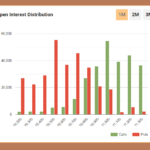Fundamentals of Index Futures
Nifty futures have a special place in the derivatives market of India. Nifty futures are the most traded in the futures market and are the most liquid contracts. You might not know this but Nifty futures is one of the 10 largest index futures in the world that are traded. Once you learn to trade in futures, I believe that like everyone else, you will definitely trade in Nifty futures and that is why it is very important to understand Nifty futures properly. But before proceeding further, I request you to once again reiterate your information about the index. This is where we discussed indexes.
I hope you are now fully aware about the index and that’s why now we move to Index futures or Nifty futures.
As we know, a futures instrument is a part of a derivative contract and it moves up or down along with the price of its underlying asset. That’s why Nifty futures also move side by side when Nifty index goes up or down.
Let’s take a look at the Snapshot of the Nifty Futures contract

Like any other futures contract, Nifty futures are also of three types – current month, mid month and far month. I have highlighted their expiry. I have also highlighted the price of Nifty futures which is available at ₹11484.9 per unit. The spot price of Nifty at the time of taking the screenshot is ₹11470.70. Here also the difference between spot price and futures price is due to the futures price formula. We will understand the futures price formula in the next chapter.
You can also see that the lot size is 75. We know that the contract value –
CV = Futures Price × Lot Size
CV = Futures Price * Lot Size
= 11484.90 × 75
= ₹ 861,367
To find out the margin required to trade the Nifty Futures contract, we used the Zerodha Margin Calculator and the margin we found is-
| Order Type | Margin |
| NRML | Rs.68,810/- |
| MIS | Rs.24,083/- |
| BO & CO | Rs.12,902/- |
Based on the above information, you now know a little bit about Nifty Futures. The biggest feature of Nifty futures is its liquidity. That’s why he is so popular. Let us see what is liquidity and how to measure it.
Impact cost
You must have heard the word liquidity time and again in the market. Simply put, liquidity is the thing that allows you to buy and sell any stock or futures contract easily. In a stock that is more liquid, large traders can buy and sell any number of shares and it does not have any major impact on the price of the stock. The big players of the market i.e. institutional investors also do more business in liquid stocks. Stocks which have high liquidity also have low volatility. If the stock is more liquid then it is also easier to place a market order in it.
Let us take as an example the share of MRF Ltd. to understand the liquidity. Suppose a foreign investment institutional investor wants to buy 5000 shares of MRF. As you know MRF is one of the most expensive stocks in terms of price. Its one share is around ₹ 38000. This means that the deal would be around ₹20 crores for buying 5000 shares. Remember that a deal of 20 crores is not a big deal for any foreign institutional investor. Well, now let’s go ahead and see how is the liquidity of MRF in the market if he wants to buy 5000 shares? For this, on the order book of MRF Limited taken from the website of NSE
let’s look

If you want to buy a stock in large quantity, then first you have to see how many shares are available for purchase in the market. As you can see in the above picture that only 4313 shares of MRF Limited are being sold in the market. It is highlighted here with a blue arrow. It is clear that the number of shares needed to complete this deal are not available in the stock market. This means that the stock of MRF Ltd. is not liquid. You can also look at the Bid Ask Spread to know the liquidity and estimate its impact cost. Knowing the impact cost for a market order can be very helpful.
Impact cost is the loss incurred in a round-trip transaction. This loss is expressed as a percentage of the average of the bid and ask prices. A round trip trade is a deal in which you buy shares at the first available price and sell the shares at the first available price. Let’s see this deal done in MRF. (Based on above order book)-
Purchase Price – ₹38364.95
Selling Price – ₹38266.25
If I have to do this roundtrip, I will be at my own loss in this deal. In fact, all roundtrip deals only make losses. The loss in this deal is-
= 38364.95 – 38266.25
= ₹ 98.7
The average of bid and ask will be –
= (38364.95+38266.25)/2
= ₹38315.60
So the impact cost will be –
Round Trip Loss / Average of Bid Ask
= 98.7 / 38315.60
= 0.3%
So where will you use this information now? Here it simply means that if you place a market order to buy or sell this stock in the market, you will incur a loss of 0.3% on account of impact cost. This may not always happen in every trade but you should be prepared for this. It also depends on how many shares you are going to deal with. So the next time you place an order to buy or sell any shares to your broker, remember that the price you see on the screen and the price at which the broker will place the deal will be the difference between the two and this difference may be due to the impact cost. Is.
The impact cost of 0.3% is too high. To understand this better, let us once look at a deal of Nifty Futures.

Price at which you can buy = 11484.95
Price at which you can sell = 11484.00
Round trip loss = 0.95 (11484.95 – 11484)
Average of Bid and Ask = (11484+11484.95)/2
= 11484.47
Impact Cost = 0.95/11484.47
= 0.0082%
This means that if you buy Nifty futures at market price, you may incur a loss of 0.0082%. If you compare this with the impact cost of MRF 0.3%, then you will understand the effect of liquidity. The salient points that have emerged from the conversation so far are-
Impact cost gives an idea of liquidity
The higher the liquidity in a stock, lower is the impact cost
The spread between the buy and sell prices also gives an idea of liquidity.
The higher the spread, the higher will be the impact cost
The lower the spread, the lower the impact cost
The higher the liquidity, the lower the volatility
If a stock has low liquidity, placing a market order is not a very good approach
We know that Nifty futures are one of the most liquid contracts in the Indian markets. Hence 0.0082% can be considered as a benchmark and on this basis it can be said that the impact cost of 0.3% of MRF is very high. From this it is clear that MRF is a very low liquidity stock. Apart from Nifty Futures, there are many contracts which are quite liquid like Bank Nifty Futures, Reliance Industries, Tata Motors, State Bank of India, Infosys, TCS ITC, DLF, Cipla etc. You can calculate the impact cost of some of these to find out their liquidity.
Advantages of trading in Nifty
As you know Nifty50 is a group of stocks. These 50 stocks are selected from different sectors of the Indian economy. Hence Nifty represents the Indian economy well. So naturally if India and Indian economy are doing well then Nifty is likely to go up. Similarly, if there is disturbance in the economy, then there is a possibility of Nifty going down. Because of this quality, trading in Nifty futures is much better than trading in a single stock. Let us look at some good reasons to trade in Nifty-
It is diversified – Sometimes it is a bit difficult to know the direction of a single stock because we are not aware of all the risks associated with it. For example, suppose I want to buy the share of Infosys Ltd because I think its quarterly results are going to be good. But if the market doesn’t like its results, the stock will go down and I will have to bear the loss. On the other hand, Nifty futures are comprised of 50 stocks, so it is not affected much by the good or bad performance of any one stock. Although there are some heavy weight stocks in Nifty too, but they do not make any kind of impact every day. Well, the point of the matter is that by trading in Nifty futures, you are saved from many types of risks, which are called unsystematic risk, you have to face only systematic risk. We will discuss both of these risk methods in more detail with the issue of hedging.
It is difficult to manipulate – Nifty consists of shares of 50 companies with the highest market capitalization, so it is not easy to manipulate it. Whereas many times such complaints are heard about any one stock that their prices are being played with. You can recall the example of Satyam Computer Services and Bhushan Steel.
Heavy Liquidity – We discussed liquidity earlier in this chapter. Since Nifty futures are highly liquid, you can trade in any volume without worrying that you will incur losses due to the impact cost.
Low Margin – The margin of Nifty futures is always less than the margin of a single stock. Generally, the margin of Nifty ranges between 12 to 15%, while the margin of a stock can be anywhere between 40 and 60%.
The direction of Nifty is based on the economy – To trade in Nifty futures you have to form an opinion about the direction of the economy whereas to know the direction of the share price of a company you have to know a lot of things.
Technical analysis is easy – In any stock or futures contract that has high liquidity, technical analysis becomes easy because it is directly affected by demand and supply and technical analysis is most dependent on demand supply. It just moves.
Low Volatility – Nifty futures have less volatility than any one stock. For example, the annual volatility of Nifty futures ranges from 16 to 17%, whereas it is much higher in some stocks. For example, Infosys has an annual volatility of up to 30%.
Highlights of this chapter
- The price of Nifty futures is based on its underlying i.e. Nifty 50 Index.
- The lot size of Nifty futures is currently 75.
- Nifty futures is one of the most liquid contracts in the Indian futures market.
- Like any other futures contract, there are three contracts available in Nifty futures namely Current Month,
- Mid Month and Far Month.
- A round trip trade is a trade in which you buy at the best available price and sell at the best available price.
- There is always a loss in a round trip trade.
- The percentage between the round trip loss and the average of the bid and ask is called the impact cost.
- Higher the impact cost, lower will be the liquidity and if the impact cost is lower then the liquidity will be higher.
- When you place a market order, you may incur a slight loss due to the impact cost.
- The impact cost of Nifty is 0.0082% which makes it the most liquid contract in the market at the moment.

Gaurav Heera is a leading stock market educator, offering the best stock market courses in Delhi. With expertise in trading, options, and technical analysis, he provides practical, hands-on training to help students master the markets. His real-world strategies and sessions make him the top choice for aspiring traders and investors.





